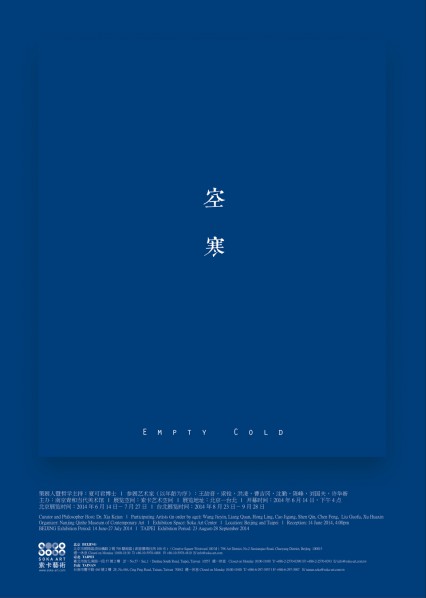
Exhibition Concept
By Xia Kejun
This academic exhibition will carry out a complete inquiry into contemporary art through four facets. First, it will approach the philosophical issues of modernity, beginning with Baudelaire’s duality of modern life between the ephemeral and the eternal to discuss whether or not “nature” can be the medium that links between the limited and the limitless. Second, it will reflect on the dilemma between “formal language” and “conceptual art” in a rewriting of modern art history, seeking a third path related to nature. Third, it will explore the modern potential of the empty cold landscapes of traditional Chinese painting, opening up a new “choratopia” through an internal dialogue between modern Chinese life and Western landscape painting. Fourth, the practices of the eight contemporary Chinese artists featured in this exhibition have already responded to the above questions in various ways, and these artists are willing to join us on this beautiful yet dangerous excursion in hopes of opening up a new possible direction for art.
1. In Carefree Wandering, Chuang Tzu laid out the mysterious notion of empty cold, which would come to have a profound influence on later poetry and painting in China, and open up the essence of a “chora-topia”: “On the distant Mount Guye there dwelt a divine man or woman whose flesh and skin were smooth as ice and white as snow; her manner was elegant and delicate as that of a virgin; She did not eat any of the five grains, but inhaled the wind and drank the dew; She mounted on the clouds, drove dragons across the sky, rambling beyond the four seas.” As a form of conceptual imagery, “empty cold” is the highest realm of Chinese traditional shanshui landscape painting, a concentration of the pure spirit of Chinese culture. This is particularly embodied in ink snowscapes and winter forest scenes. Empty cold shanshui paintings express, in a reserved fashion, the chora-topia opened up by Chuang Tzu’s “spirit of cleansing snow.” This cold, desolate and sublime imagery is like a secret religion of mindfulness in Chinese culture, a hidden ritual of “cleansing” the soul, just as poet Su Dongpo writes: let us often see skin of snow at four seasons.
2. Why have we chosen “empty cold” as the theme? This is directed at the tendency in today’s society towards excess heat, excess recklessness, excess consumption and excess waste, directed at the haze shrouding China’s skies and lands. We will use “cold” to lower the temperature of the “heat,” and use “emptiness” to treat the consumption and waste. Chinese contemporary life lacks the qualities of spiritual life. It must be balanced and adjusted through extremely cold, extremely empty poeticism. From cool to cooler to coldest, snow, with its sense of emptiness, can calm our restless spirits.
3. This exhibition also enters into a dialogue between “landscape painting” and “shanshui painting” on an academic level. It attempts to explore, on a deep level, the properties and spirit of ink, as well as the progression in the West from landscape painting to abstract painting, through the lens of the artists’ works, engaging in a deep dialogue. Contemporary Chinese art must contribute a new language of creative transformation from within its own culture. This Empty Coldor Infra-mince of Snow-scapeexhibition is a further progression along the lines of the previous exhibitions Infra-Thin and Infra-White. The “art of non-dimensionality” will manifest itself within the visual perceptive language of empty cold and thereby purify our souls. It will also form a new linguistic model for perceiving the world. This exhibition will attempt to use the sense of snow to rediscover the properties of iInk, to rediscover remnant naturalness, and to unfold a vision for the future.
4. This exhibition will attempt to engage a deep dialogue between the views of nature in Chinese thought with the artistic concepts of the West. This exhibition includes oil paintings and ink paintings. The Chinese painting of the future must find common ground between the two. The artists in this exhibition each have their own perception of empty cold and each present it in their own unique visual language of painting, reaching unique discoveries regarding this empty nature. From the naturalness of nature to the naturalness of cultural memory and on to the nature of abstraction, from emptied images of nature to an infra-thin nature, to a holy nature and an empty, spiritual nature, each of the participating artists is seeking to discover a naturalness of “chora-topia,” one that differs from the utopia and heterotopia of the West.
5. The participating artists are connected in terms of painting language to the theme of “empty cold” through unique creative approaches. Wang Jieyin works with the simpleand pure deform of nature and the lingering echoes of sound. Liang Quan works with the naturalness of abstraction and the lingering flavor of prosaicness. Hong Ling approaches the naturalness of nature and the silent confluence of spirits. Cao Jigang transforms the tones of nature into ink, and lingering sorrow into silence. Shen Qin works with gardens of nature and the open space of roving dreams. Chen Feng approaches the cultural memory of nature and the afterimage of hills. Liu Guofu’s is the spirit of nature and the spirits of the afterimage.Xu huaxin ink works have the texture of jad with the sense of empty cold.
About the exhibition
Dates: Jun 14, 2014 - Jul 27, 2014
Opening: Jun 14, 2014, 16:00, Saturday
Venue: Soka Art Center (Beijing) (Beijing, China)
Artists: Cao Jigang, Chen Feng, Hong Ling, Liang Quan, Liu Guofu, Shen Qin, Wang Jieyin, Xu Huaxin
Organizer: Nanjing Qinghe Museum of Contemporary Art
Courtesy of the artists and Soka Art Center.




























